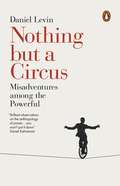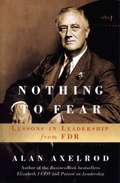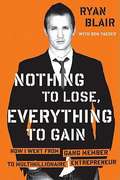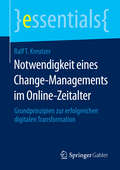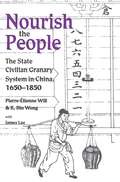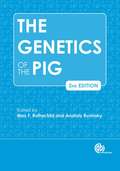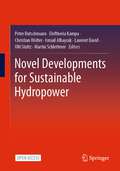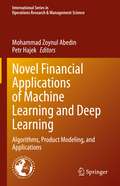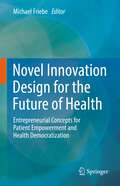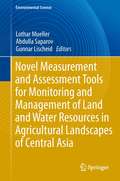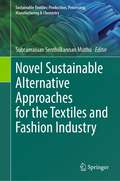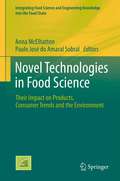- Table View
- List View
Nothing but a Circus: Misadventures among the Powerful
by Daniel Levin'Brilliant observations on the anthropology of power. You will laugh aloud and you won't put it down' Daniel KahnemanIn this eye-opening exploration of the human weaknesses for power, Daniel Levin takes us on a hilarious journey through the absurd world of our global elites, drawing unforgettable sketches of some of the puppets who stand guard, and the jugglers and conjurers employed within. Most spectacular of all, however, are the astonishing contortions performed by those closest to the top in order to maintain the illusion of integrity, decency, and public service. Based on the author's first hand experiences of dealing with governments and political institutions around the world, Nothing but a Circus offers a rare glimpse of the conversations that happen behind closed doors, observing the appalling lengths that people go to in order to justify their unscrupulous choices, from Dubai to Luanda, Moscow to Beijing, and at the heart of the UN and the US government.
Nothing to Fear: Lessons in Leadership from FDR
by Alan AxelrodFrom the preface: "What you will find here is a collection of leadership lessons drawn from the public words of Franklin Roosevelt, beginning with his unsuccessful run for the vice presidency in 1920, moving through his terms as governor of New York, and across the entire of his presidency during an economic depression of depth and duration, and during a war of unheard-of and consequence."
Nothing to Lose, Everything to Gain
by Don Yaeger Ryan BlairThe New York Times bestseller by a former gang member turned multimillionaire entrepreneur Like many entrepreneurs, Ryan Blair had no formal business education. But he had great survival instincts, tenacity, and, above all, a "nothing to lose" mind-set. His middle-class childhood came to an abrupt end when his abusive father succumbed to drug addiction and abandoned the family. Blair and his mother moved to a bad neighborhood, and soon he was in and out of juvenile detention, joining a gang just to survive. Then his mother fell in love with a successful entrepreneur who took Ryan under his wing. With his mentor's help, Blair turned himself into a wildly successful businessman. He started his first company, 24/7 Tech, at the age of twenty-one, and since then has created and sold several companies for hundreds of millions of dollars. Now Blair shows readers how to start and grow their own profitable businesses. Sharing lessons from his mentors and advice from his own life-changing experiences, Blair provides an inspirational guide for people willing to put in the hard work, time, and dedication needed to achieve entrepreneurial success.
Notre tour de polluer
by Ronald RwakigumbaLoin de ralentir le développement, les modèles d’industrialisation respectueux de l’environnement comme l’industrie verte ouvrent la voie à un avenir meilleur. Au-delà du profit, les entreprises soucieuses des personnes et de la planète offrent des rendements plus stables et durables. Il doit y avoir un autre modèle de croissance économique qui dissocie la croissance du PIB de l’augmentation des émissions de gaz à effet de serre (GES). Je postule dans ce livre que si les modèles de développement passés ont permis une croissance grâce à la pollution industrielle, les pays en développement n’ont pas besoin de suivre cette voie. L’industrie verte, qu’elle soit axée sur l’efficacité des ressources, la réduction de la pollution ou la vulnérabilité flagrante à la destruction des moyens de subsistance et des infrastructures induite par l’inaction climatique, montre une plus grande viabilité économique comme voie à suivre. Face au défi de concilier développement et objectifs écologiques, certains ont souvent soutenu que l’industrialisation était une opportunité pour les pays les moins avancés, à qui c’était désormais à leur tour de polluer l’environnement, tout comme les pays développés l’ont fait pendant de nombreuses décennies. D’autres pays ont également fait valoir qu’ils ont encore de quoi polluer, contrairement aux États développés qui sont apparemment surpeuplés et dont l’écosystème est au point de rupture. L’ironie que je vois est que les États développés qui cherchent de plus en plus à dissocier la croissance du PIB de l’augmentation des émissions de GES sont également les mieux préparés à résister aux événements climatiques extrêmes. Ce n'est PAS à notre tour de polluer. Les entreprises ont centré leur seul objectif sur la maximisation de la valeur actionnariale, en partant du principe que les actionnaires supportent uniquement le risque résiduel. Nous
Notwendigkeit eines Change-Managements im Online-Zeitalter: Grundprinzipien zur erfolgreichen digitalen Transformation (essentials)
by Ralf T. KreutzerUm einen überzeugenden Auftritt zu erreichen, müssen auch die Mitarbeiter in den Prozess zum Aufbau einer positiven Unternehmensreputation eingebunden werden. Dazu ist es erforderlich, zunächst den Stellenwert der Mitarbeiter beim Aufbau einer Corporate Reputation zu erkennen. Dann sind entsprechende Maßnahmen aufzusetzen, damit die Mitarbeiter eines Unternehmens als Markenbotschafter für ,,ihr" Unternehmen tätig werden können. Dabei wird deutlich, dass gerade die Mitarbeiter einen wesentlichen Beitrag leisten können, damit sich ein Unternehmen vom Wettbewerb abheben kann.
Nourish the People: The State Civilian Granary System in China, 1650–1850 (Michigan Monographs In Chinese Studies #60)
by R. Bin Wong Pierre-Etienne WillThe Qing state, driven by Confucian precepts of good government and urgent practical needs, committed vast resources to its granaries. Nourish the People traces the basic practices of this system, analyzes the organizational bases of its successes and failures, and examines variant practices in different regions. The volume concludes with an assessment of the granary system’s social and economic impact and historical comparison with the food supply policies of other states.
Nourishing the Land, Nourishing the People: The Story of One Rural Development Project in the Deep South of Madagascar That Made a Difference
by Brett Shapiro Assefa Woldeyes Harifidy Ramilison Andrianiainasoa Rakotondratsima Benoît ThierryThis book covers the progress of a development initiative in Madagascar that enabled a region suffering from chronic drought and famine to provide food and become the area's breadbasket. Working with local people, the project delivered increased new cultivations, abundant harvests and improvements in infrastructure, media access, education and health.
Nova Chemical Corp.
by Scott P. MasonA diversified chemical company must decide whether to sell its basic chemicals division and expand the specialty chemicals division.
NovaStar Financial: A Short Seller's Battle
by Suraj Srinivasan Amy KaserThe NovaStar case describes the challenges faced by short seller Marc Cohodes of hedge fund Rocker Partners as he tried to expose what he thought was widespread fraud in mortgage lender NovaStar Financial. The case is set in the time period from 2001 to 2007 and tracks the growth of the subprime industry and its collapse leading to the financial crisis. The case describes the business model of NovaStar, a leading subprime mortgage lending company, and its accounting practices with a focus on the key risks and opportunities facing the company. The case requires students to put themselves in the shoes of Marc Cohodes in order to understand the business model and accounting numbers and to identify if the financial performance is a good representation of the true economic performance. In particular, students learn accounting concepts related to securitization, gain on sale accounting, valuation of available for sale securities, and analyzing the statement of cash flows. The case also allows students to understand the roles and incentives of various capital market participants such as sell-side analysts, the media, auditors, and the Securities and Exchange Commission (SEC).
Novartis (A): Being a Global Leader
by Srikant M. Datar Carin-Isabel KnoopFor the Novartis leaders, the decision to "use stretch budgets again next year" highlights the tension between candor and empowerment and command-and-control, between the new and the old, between high performance and business as usual, between Ciba and Sandoz. Management must decide what kind of company and culture they want to build.
Novartis AG: Science-Based Business
by H. Kent Bowen Courtney PurringtonNovartis is a science-based drug company, which has important implications for its business strategy. It is one of the largest pharmaceutical companies in the world with over $38B in sales in 2007. Pharmaceuticals account for slightly over $24B of that total. In 2007, corporate R&D spending was $6.43B, or almost 17% of net sales. Novartis executive leaders believe in scientific progress and that large-scale investments in science will therefore result in long-term pay-offs in terms of profits and discoveries that benefit mankind. Novartis' business strategy is closely tied to its research strategy, which emphasizes extensive internal discovery and development capabilities leading to organic growth along with explicit external alliances and collaborations to supplement its core capabilities. Like its competitors, Novartis faces many challenges in terms of moving research from the bench to the bedside. Five years after undertaking the restructuring of the discovery research organization, CEO Daniel Vasella is pleased with its progress, including many more development projects in the pipeline and new molecular entities. Nevertheless, the company faces a number of challenges, including generic drugs, patent infringements in developing countries, and pricing pressure from governments and health insurers in the United States. Given these challenges, Novartis must decide how much to spend on R&D overall, how to arrive at the right mix between organic growth and external collaboration and in-licensing, and how to measure success when it takes so many years to develop and launch a successful drug.
Novartis Pharma: The Business Unit Model
by Srikant M. Datar Cate Reavis Carin-Isabel KnoopIn June 2000, Novartis reorganized its pharmaceutical business to form global business units in oncology, transplantation, ophthalmology, and mature products. The remaining primary care products continued to be managed within global functions (e.g., R&D and marketing). The new organization created a matrix structure and new roles and responsibilities for heads of business functions, CEOs of new business units, and country managers operating in over 100 countries.
Novartis Pharmaceuticals Corp: Redefining Success in the U.S. (B)
by Gautam Mukunda Thomas J. Delong Aldo SesiaThis (B) case describes the actions Andre Wyss, President of Novartis Pharmaceuticals Corp., took in early 2012 to transform the company's General Medicines group and build its speciality medications marketing the selling capabilities in the face of falling revenues and an imminent workforce reduction. Rather than downsize the organization quickly to save costs, Wyss and his team took a different approach. They told the organization's employees that there would be a significant workforce reduction but it would not occur for several months. In the meantime, Wyss asked the employees to help build the new capabilities and put processes in place to support the move into specialty medications. It was a bold decision and defied convention.
Novartis' Sandoz: Between Generics and Pharma
by Krishna G. Palepu Carin-Isabel KnoopSandoz, which made a significant investment in bio-similars as a way to differentiate itself from its generic drug industry peers, has to negotiate with its parent company and the innovative pharma division on how best to commercialize its bio-similar portfolio. What is the best way to balance the parenting advantage of Novartis with the unique demands of the generic drug industry?
Novartis: A Transformative Deal
by David J. Collis Ashley HartmanWhen Joe Jimenez became CEO of Swiss-based Novartis in 2010 replacing longtime CEO Dan Vasella, he assumed control of one of the top pharmaceutical companies in the world. Vasella, an avowed advocate of diversification, had expanded the scope of the company and structured it into sixteen distinct business units ranging from animal health to oncology while "actively fostering competition between those divisions for resources." Shortly after assuming his position, Jimenez initiated a strategic review that sought to concentrate the portfolio on businesses where Novartis could be at global scale in attractive markets. Rather than following competitors, like Pfizer, in a single mega-acquisition, Jimenez and his M&A team decided to achieve this goal through targeted transactions, or "precision M&A". By 2014 after examining twenty or so possible deals, the company was in the process of negotiating a multi-billion dollar asset swap with Glaxo-Smith Kline (GSK) that was unprecedented in the pharma industry. Although Novartis would improve its position in oncology by acquiring GSK's promising drug portfolio, it had to sell its vaccines and animal health businesses, while giving up control of the over-the-counter (OTC) business. Jimenez and his team knew the offer was "all-or-nothing" and struggled over whether to accept it, or reject it and move in another direction.
Novartis: A Transformative Deal
by David J. Collis Ashley HartmanWhen Joe Jimenez became CEO of Swiss-based Novartis in 2010 replacing longtime CEO Dan Vasella, he assumed control of one of the top pharmaceutical companies in the world. Vasella, an avowed advocate of diversification, had expanded the scope of the company and structured it into sixteen distinct business units ranging from animal health to oncology while "actively fostering competition between those divisions for resources." Shortly after assuming his position, Jimenez initiated a strategic review that sought to concentrate the portfolio on businesses where Novartis could be at global scale in attractive markets. Rather than following competitors, like Pfizer, in a single mega-acquisition, Jimenez and his M&A team decided to achieve this goal through targeted transactions, or "precision M&A". By 2014 after examining twenty or so possible deals, the company was in the process of negotiating a multi-billion dollar asset swap with Glaxo-Smith Kline (GSK) that was unprecedented in the pharma industry. Although Novartis would improve its position in oncology by acquiring GSK's promising drug portfolio, it had to sell its vaccines and animal health businesses, while giving up control of the over-the-counter (OTC) business. Jimenez and his team knew the offer was "all-or-nothing" and struggled over whether to accept it, or reject it and move in another direction.
Novartis: Leading a Global Enterprise
by Krishna G. Palepu Carin-Isabel Knoop William W. GeorgeNovartis, the world's leading healthcare company, was formed in 1996 out of a merger of two very different, mid-tier Switzerland-based pharma companies. The case traces the company's evolution over the past 17 years, as it transformed into a truly global enterprise with 127,000 employees of 153 nationalities in 140 countries generating $56.7 billion in 2012 revenues and $9.6 billion in net income, making the firm one of the world's largest and most profitable companies. CEO since 2010, Joe Jimenez had taken over from one of the merger's architects and visionary legacy CEO Daniel Vasella. He recognized that the global health care environment would create severe challenges for Novartis in the years ahead and that Novartis needed to make sure it had the right strategy, structure, talent and spirit to live up to its ambitions.
Novel Developments for Sustainable Hydropower
by Peter Rutschmann Ismail Albayrak Eleftheria Kampa Christian Wolter Laurent David Ulli Stoltz Martin SchlettererThis open access book presents (selected) new and innovative developments for sustainable and fish-friendly hydropower. It offers unique insights into the challenges, practices and policies of hydropower developments across 8 European countries, providing examples from on-site studies and European-wide analyses. The case studies throughout the book are practical “real-world” examples, which are intended to serve as inspiration for anyone who would like to know more about how solutions for more sustainable hydropower production can be designed and implemented. Hydropower is an important renewable energy source, which, however, can also impact aquatic ecosystems, fish populations and hydro-morphology. EU and national water, environmental and energy legislation strive for sustainable energy and water resource management as well as the protection of important habitats and species. These have an effect on the requirements and decision making processes for hydropower planning, commissioning and operation. With a high variety of measures existing and site-specific conditions as well as national and EU level legal requirements to consider, it can be difficult to determine, what issues to address and which measures to implement.
Novel Financial Applications of Machine Learning and Deep Learning: Algorithms, Product Modeling, and Applications (International Series in Operations Research & Management Science #336)
by Petr Hajek Mohammad Zoynul AbedinThis book presents the state-of-the-art applications of machine learning in the finance domain with a focus on financial product modeling, which aims to advance the model performance and minimize risk and uncertainty. It provides both practical and managerial implications of financial and managerial decision support systems which capture a broad range of financial data traits. It also serves as a guide for the implementation of risk-adjusted financial product pricing systems, while adding a significant supplement to the financial literacy of the investigated study. The book covers advanced machine learning techniques, such as Support Vector Machine, Neural Networks, Random Forest, K-Nearest Neighbors, Extreme Learning Machine, Deep Learning Approaches, and their application to finance datasets. It also leverages real-world financial instances to practice business product modeling and data analysis. Software code, such as MATLAB, Python and/or R including datasets within a broad range of financial domain are included for more rigorous practice. The book primarily aims at providing graduate students and researchers with a roadmap for financial data analysis. It is also intended for a broad audience, including academics, professional financial analysts, and policy-makers who are involved in forecasting, modeling, trading, risk management, economics, credit risk, and portfolio management.
Novel Foods and Edible Insects in the European Union: An Interdisciplinary Analysis
by Lucia Scaffardi Giulia FormiciThis open access book proposes an in-depth study on a vast range of issues connected to the regulation of Novel Foods in the European Union, pursuing an interdisciplinary approach and thus providing a comprehensive picture of this complex topic. Particular attention is paid not only to the current EU legislative framework, its positive innovations, unsolved problems and limits, but also to food safety issues and the potential impact of Novel Foods on sustainability and food security. In addition, the book focuses on a particular category of Novel Foods: insects for human consumption. These products recently gained momentum after the first EU Commission authorisation of dried yellow mealworm (Tenebrio molitor) in 2021. The book contributes to the lively public debate following this long-awaited authorisation by examining the legal issues arising from the application of the Novel Foods Regulation to these peculiar new foods; the EFSA risk assessment evaluations; the consumers’ perceptions and potential future of insect-based products’ market in the EU. By providing such an extensive analysis, including recent developments and future prospects, the book represents a valuable tool for students and academics, but also institutions and public authorities, helping them understanding the various challenges related to Novel Foods and edible insects. Furthermore, it seeks to promote an informed debate in order to find innovative solutions to pressing problems concerning how to feed the world of tomorrow.
Novel Innovation Design for the Future of Health: Entrepreneurial Concepts for Patient Empowerment and Health Democratization
by Michael FriebeThis book highlights the reasons for an urgently needed revision of the current global healthcare setup, discusses the needed mindset for a future of health, and provides a comprehensive development toolset for disruption (and for the needed incremental innovations towards disruption).Today’s biomedical and health innovation related research in universities encourages activities that lead to incremental innovations with a relatively low risk of failure. The healthcare industry on the other hand provides tools and devices for established healthcare providers to improve the diagnosis and therapy/ treatment of the patients’ health problems. The patient is not in the center of healthcare provision however, and prevention and prediction are not core goals. The current health setup needs to be challenged and disrupted.Disruptions are coming from technologies or processes that lead to a significant (>10x) reduction in cost or price/ performance and that also come with new business models. The need for change, effects of exponential technologies, and the needed shift to prevention and to homecare for health democratization and patient empowerment will be discussed in detail in the first parts of the book. The subsequent sections address several innovation methods with a focus on a novel meta methodology named Purpose Launchpad Health. This is followed by a comprehensive discussion on health entrepreneurship activities and needs. The final section of the book addresses how to train students to become entrepreneurial health innovators, presenting successful curricula and examples of health incubation and accelerator setups. All of the innovation tools presented and used in this book are summarized in the final chapter to help the reader get started planning an entrepreneurial venture.Written by experts from academia and industry, the book covers important basics and best practices, as well as recent developments. Chapters are concise and enriched with key messages, learning objectives and real innovation examples to bridge theory and practice. This book aims to serve as a teaching base for health innovation design and to prepare for health-related entrepreneurial ventures.Readers with medical, biomedical, biotechnology, and health economics backgrounds - and anyone who wants to become a future oriented health innovator or who believes in disruptive approaches - will find this book a useful resource and teaching tool for developing validated products/ services and processes for the future of health.
Novel Measurement and Assessment Tools for Monitoring and Management of Land and Water Resources in Agricultural Landscapes of Central Asia
by Lothar Mueller Abdulla Saparov Gunnar LischeidThe book aims to initiate a sustainable use of land and water resources in Central Asia by the transfer of scientific methods. It deals with the most advanced methods worldwide for better monitoring and management of water and land resources. We offer an array of methods of measuring, assessing, forecasting, utilizing and controling processes in agricultural landscapes. These are laboratory and field measurement methods, methods of resource evaluation, functional mapping and risk assessment, and remote sensing methods for monitoring and modeling large areas. The book contains methods and results of data analysis and ecosystem modeling, of bioremediation of soil and water, field monitoring of soils, and methods and technologies for optimizing land use systems as well. The chapter authors are inventors and advocators of novel transferrable methods. The book starts with an analysis of the current state of water and land resources. Finally concrete proposals for the applicability of novel methods are given.
Novel Sustainable Alternative Approaches for the Textiles and Fashion Industry (Sustainable Textiles: Production, Processing, Manufacturing & Chemistry)
by Subramanian Senthilkannan MuthuEnvironmental impacts created by the textiles and fashion sector are well known and acknowledged by various stakeholders involved in the entire supply chain. The entire lifecycle of textile products creates various impacts to the environment and hence any attempts to alleviate the impacts are highly welcomed. The whole sector is keen to investigate novel sustainable alternatives in terms of raw materials, processes, approaches to make the entire textiles and fashion sector more sustainable. This broad title of novel sustainable alternatives can be split into three subtopics: novel raw material alternatives, novel process alternative and novel alternative approaches. This volume is dedicated to deal with the novel sustainable alternative approaches for the textiles and fashion industry.
Novel Technologies in Food Science
by Anna Mcelhatton Paulo José do Amaral SobralThe book covers novel technologies, including high pressure, antimicrobials, and electromagnetism, and their impact.
Novell (A): When an Activist Hedge Fund Came Calling on the Board
by Richard L. NolanNo corporation and its board of directors is immune to a disruptive shareholder activist attack. The Novell (A) and (B) cases take students through a shareholder activist attack and its aftermath -- a saga that spanned 5 years. The cases outline the activist playbook in conducting an attack, the board's response, and key decisions that must be made.
